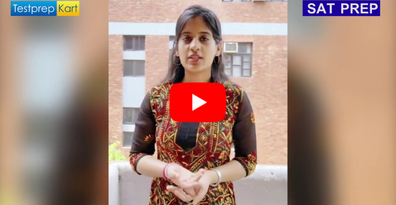Digital SAT Preparation in New York
The digital SAT is a new version of the systematize college admissions test offered by the College Board. It launched in Spring 2024 for US students and offers several key differences compared to the traditional paper-and-pencil SAT: Take a look into the new format, here it is:
- Digital format: You’ll take the test on a laptop or tablet (including your own device in some cases) at a testing center.
- Shorter test: It’s a more streamlined experience, taking roughly 2 hours compared to 3 hours for the paper version.
- Adaptive testing: The difficulty of the questions adjusts based on your performance. You’ll see easier questions initially, and if you answer them correctly, the test will present harder questions worth more points.
- Combined sections: Reading and Writing are merged into a single Reading & Writing section, while Math remains separate.
- Calculator allowed: Unlike the paper SAT, you can use the built-in calculator throughout the entire Math section for the digital version.
Digital SAT Exam Highlights
| Exam Name | SAT (Digital) |
| SAT full form | Scholastic Assessment Test |
| Official Website | https://www.collegeboard.org/ |
| SAT Exam Duration | 2 hours 14 minutes |
| Most popular for | Undergraduate courses in the US and Canada |
| Conducted by | College Board |
| Mode of Exam | Online |
| SAT Fee for Indian Students | $60 + $43 +$18.54 = ₹10,075 (approx) |
| Score Range | on a 1600 scale point |
| SAT Contact Info | The College Board National Office 250 Vesey Street New York, NY 10281 Phone: 212-713-8000 |
Some Essential Factors :
- Students belonging to the age group of 17 to 19 appear for the SAT exam in maximum numbers.
- For USA students, the Digital SAT exam is applicable by 2024 onwards, that is, March, May, June, August, October, November, and December but the number of attempts is limited to 5.
- The knowledge skill of students is tested on the basis of the Critical Reading section, Mathematics section and Writing section.
- Earlier The SAT questionnaire was designed for the time duration of 3-4 hours but now Digital SAT is of 2 hours 14 minutes.
- The range of scores varies from 200 to 800 on each of the 2 sections , i.e., you can get a minimum score of 600 and maximum score of 1600.
Explore the SAT Course Book a Free Trial Session
Check the SAT Preparation Online Courses
|
Advanced Level |
Intermediate Level |
Intermediate Level |
Intermediate Level |
|||
|
Digital SAT Prep Online – 42 hrs |
Digital SAT Prep Online – 60 hrs |
Digital SAT Prep Online – 72 hrs |
Digital SAT Prep Online – 90 hrs |
|||
|
Rs. 58,174 |
Rs. 73,614 |
Rs. 90,134 |
Rs. 1,06,654 |
|||
|
USD 696.67 |
USD 881.56 |
USD 1,079.34 |
USD 1277.16 |
|||
|
Digital SAT (42 Hrs |
Digital SAT (60 Hrs) Details: |
Digital SAT (72 Hrs) Details: |
Digital SAT (90 Hrs) Details: |
|||
| 1. Live & Interactive Real Time Sessions 2. Best English and Maths Experts For Digital SAT 3. High Score Course Modules 4. Session Wise Assignments 5. 3 Types of Tests – Online, Offline and Hard Copy 6. Practice of 3600 questions during the entire course 7. Comprehansive Study Material – Module Wise 8. Regular Doubt Removal Sessions 9. Rapid Reading Excercises 10. Suggested Reading Sessions 11. Special Tips and Techniques to get a perfect score |
1. Live & Interactive Real Time Sessions 2. Best English and Maths Experts For Digital SAT 3. High Score Course Modules 4. Session Wise Assignments 5. 3 Types of Tests – Online, Offline and Hard Copy 6. Practice of 3600 questions during the entire course 7. Comprehansive Study Material – Module Wise 8. Regular Doubt Removal Sessions |
1. Live & Interactive Real Time Sessions 2. Best English & Maths Experts For SAT 1 3. Scientifically Designed Course Modules 4. Session Wise Assignments 5. 3 Types of Tests – Online, Offline and Hard Copy 6. Practice of 3600 questions during the entire course 7. Comprehansive Study Material – Module Wise 8. Regular Doubt Removal Sessions 9. Rapid Reading Excercises 10. Suggested Reading Sessions 11. Special Tips and Techniques to get a perfect score |
1. Live & Interactive Real Time Sessions 2. Best English & Mathematics Experts For Digital SAT 3. Scientifically Designed Course Modules 4. Session Wise Assignments 5. 3 Types of Tests – Online, Offline and Hard Copy 6. Practice of 3600 questions during the entire course 7. Comprehansive Study Material – Module Wise 8. Regular Doubt Removal Sessions 9. Rapid Reading Excercises 10. Suggested Reading Sessions 11. Special Tips and Techniques to get a perfect score |
|||
SAT Private Tutoring
| SAT Tutoring / Course | Hours Package |
| Feature | Description |
| Personalized Instruction | Tailored lessons to address the specific strengths and weaknesses of the individual student. |
| Customized Curriculum | Development of a study plan focused on the student’s goals and target scores. |
| Flexible Scheduling | Ability to schedule sessions at convenient times for the student. |
| Individual Attention | Dedicated attention from the tutor to address the student’s questions and concerns. |
| Detailed Feedback | Comprehensive feedback on practice tests and assignments to track progress. |
| Targeted Strategies | Instruction on specific test-taking strategies and techniques to improve scores. |
| Adaptive Approach | Adjustments in teaching methods based on the student’s learning style and pace. |
| Access to Resources | Provision of study materials, practice tests, and supplementary resources. |
| Continuous Support | Availability of support between sessions via email or messaging for additional assistance. |
| Performance Tracking | Regular assessment of progress and performance to identify areas for improvement. |
| Course Details | Know More |
Digital SAT Live Sessions
SAT Exam Datasheet 2025
| SAT Test Date | Registration Deadline | Late Registration & Testing Changes Deadline |
| March 8, 2025 | February 21, 2025 | February 25, 2025 |
| May 3, 2025 | April 18, 2025 | April 22, 2025 |
| June 7, 2025 | May 22, 2025 | May 27, 2025 |
| August 23, 2025 | To Be Announced | To Be Announced |
| September 13, 2025 | To Be Announced | To Be Announced |
| October 4, 2025 | To Be Announced | To Be Announced |
| November 8, 2025 | To Be Announced | To Be Announced |
| December 6, 2025 | To Be Announced | To Be Announced |
Digital SAT Exam Structure
Digital SAT English Section Exam Structure (Reading and Writing)
The Reading and Writing section contains 2 modules. There are 25 operational questions and 2 pretest questions in each module. The time duration for each module is 32 minutes. You will find the exam structure in detail in the table given below:
| DIGITAL SAT EXAM STRUCTURE | |
| Section | Reading and Writing |
| Test length | Module 1: 25 operational questions and 2 pretest questions Module 2: 25 operational questions and 2 pretest questions |
| Time per module | Module 1: 32 minutes and Module 2: 32 minutes |
| Number of questions | 54 questions |
| Total time | 64 minutes |

Digital SAT Mathematics Section Exam Structure
The Mathematics section contains 2 modules. There are 23 operational and 2 pretest questions in each module. The total time allotted for the Mathematics section is 70 minutes, with 35 minutes for each module. Now in the Digital SAT, the calculator has already been added to the SAT Exam Window so you can use the calculator any time during the Digital SAT Exam. You will find the exam structure in detail in the table given below:
| DIGITAL SAT EXAM STRUCTURE | |
| Section | Mathematics |
| Test length | Module 1: 20 operational questions and 2 pretest questions Module 2: 20 operational questions and 2 pretest questions |
| Time per module | Module 1: 35 minutes and Module 2: 35 minutes |
| Number of questions | 44 questions |
| Total time | 70 minutes |

When should I take the SAT?
The ideal time to appear in Digital SAT exam is depends on the several factor are academic preparedness, college application deadlines, and how much time you have to study and prepare. Here are some general guidelines:
1. Junior Year (11th Grade):
- Many students opt for their 1st attempt of digital SAT exam during their junior year. This allows them to have adequate time to re-appear the exam if needed before college application deadlines.
- You can opt for SAT exam in the spring of your junior year, around March, May, or June. This timing gives you the opportunity to use your summer break for further preparation or to retake the exam if necessary .
2. Senior Year (12th Grade):
- Students may re-appear in grade 12th which may lead to improve their score or If students didn’t take the SAT exam their junior year.
- Make sure to check college application deadlines to ensure you have your scores sent in on time.
3. Consideration for Early Decision/Early Action:
- If you’re applying for early decision or early action to colleges, you may need to take the SAT earlier, potentially in the fall of your senior year.
- Check with the specific colleges you’re interested in to determine their requirements and deadlines.
4. Preparation Time
- Give yourself enough time to prepare for the exam. This may vary depending on your current skill level and how much time you can dedicate to studying.
- Consider taking practice tests to gauge your readiness and identify areas for improvement.
5. Score Reporting:
- Keep in mind the time it takes for scores to be reported to colleges. Scores are typically available about two to three weeks after the test date, but it may take longer during peak times.
Guidelines for the students for applying digital SAT
There are 2 sets of guidelines are there to consider for the digital SAT: Applying and taking the test. Here’s a distinguish:
Applying for the Digital SAT:
- Eligibility: The digital SAT is currently only available for US high school students.
- Registration: You’ll register through College Board’s website just like the traditional SAT.
- Testing Dates: The digital SAT is offered multiple times throughout the year. Check the College Board website for specific dates and registration deadlines.
- Device Requirements: You can use your own laptop or tablet for the test in some cases, but there are specific requirements. Review the College Board’s website for details on operating systems, battery life, and other specifications.
- School-managed devices: Some schools may provide devices for students to use during the test.
Taking the Digital SAT:
- Test Day Essentials: You’ll need a valid ID, your admission ticket (accessed through the Bluebook app), a fully charged device with the Bluebook app downloaded, and pencils for scratch work (proctor will provide scrap paper). Check the College Board website for a complete list of what to bring and what not to bring.
- Test Center Regulations: Standard test center rules apply, such as arriving on time, no talking or unauthorized materials during the test.
- Digital Testing Regulations:
- No switching between programs or applications during the test.
- No going back to previous sections once you’ve moved on.
- Only use the authorized on-screen calculator (or your approved handheld calculator) on the Math section.
- No unauthorized communication or leaving the testing area without permission.
Digital SAT Student Review
At TestprepKart we feel satisfied having worked closely with students and parents toward achieving a common objective of a Great SAT Score and Selection in a Good University. Here is what our students speak about SAT Coaching at TestprepKart.
.png) |
 |
||
 |
 |
SAT eBook
It is very important to know minor to major facts when starting your preparation for an aptitude-based exam like SAT, with updates that can help with your SAT preparation. We are pleased to announce the release of TestprepKart’s free SAT study guide for the new SAT. This free SAT eBook gives you everything you need to know about the test, from content to content mastery, among the top practice goals you need.
FAQS
Q. What is Digital SAT?
A. The Digital SAT is the completely revamped version of the traditional paper-and-pencil SAT college entrance exam. Launched in Spring 2024, it offers a more streamlined and tech-focused testing experience.
Q. What is time duration for Digital SAT?
A. The total time duration for the Digital SAT is 2 hours and 14 minutes. This is shorter compared to the 3-hour duration of the traditional paper-and-pencil SAT.
Q. Do I need to carry my own laptop or calculator on exam?
A. Laptop: You don’t need to carry your own device rather than you may use device issued by school. You can use laptop or tablet which is compatible with College Board’s guidelines. They have a list on their website.
Calculator: You don’t need to bring your own calculator for the Digital SAT. A scientific calculator is accessible on the screen throughout the Math section. Even though a calculator is provided, it’s still recommended to be comfortable using the digital calculator interface during your practice sessions.
Q. What is the best score for digital SAT?
A. There isn’t a single “best” score for the Digital SAT, as it depends on the colleges you’re applying to. However, here’s a breakdown to help you understand score ranges:
-
Overall Score Range: The Digital SAT is scored on a scale of 400-1600 (200-800 for each Reading/Writing and Math section).
-
Highly Competitive: A score of 1580 or higher is considered excellent, placing you in the top 99% of test-takers. This would be ideal for highly selective colleges.
-
Strong Score: A score of 1210 or higher is generally considered strong, putting you in the top 25% of test-takers. This can be competitive for many colleges.
-
College Benchmarks: The most important factor is the score range for the colleges on your list. Research the average SAT scores for admitted students at your target colleges. This will give you a better idea of what score to aim for.
Here’s what to consider when aiming for a good score:
- College Requirements: Some colleges may have minimum SAT score requirements. Make sure you meet those benchmarks.
- Overall Application Strength: SAT scores are just one piece of the college application puzzle. Consider your GPA, extracurricular activities, essays, and recommendation letters.
Q. How do I prepare for math’s for the digital SAT?
A. Here’s a guide to help you prepare for the math section of the Digital SAT:
Solidify Core Concepts:
- Review: Make sure you have a solid foundation in the math topics covered on the Digital SAT, including algebra, geometry, data analysis, and probability.
Master the Digital Format:
- Practice Tests: Take advantage of digital practice tests offered by the College Board and Khan Academy. These will familiarize you with the interface, question types, and time constraints of the digital format.
- Calculator Familiarity: Even though a calculator is provided, practice using the on-screen calculator during your practice tests. Get comfortable navigating its functions.
Develop Strategic Approaches:
- Identify Strengths & Weaknesses: Analyze your practice test results to pinpoint your strong and weak areas in math. Focus on improving your weaker areas with targeted practice.
- Problem-Solving Strategies: Learn time-saving techniques like estimation and plugging in answer choices.
- Focus on Understanding: Don’t just memorize formulas. Aim to understand the underlying concepts to tackle even unfamiliar problems.
Q. What is the scoring system ?
A. The scoring system for the Digital SAT remains the same as the traditional paper SAT: a 400-1600 point scale. Here’s a breakdown:
- Section Scores: The SAT is divided into two sections: Reading & Writing (combined) and Math. Each section is scored on a scale of 200-800 points.
- Total Score: Your total SAT score is the sum of your Reading & Writing section score and your Math section score. It can range from a minimum of 400 (200 in each section) to a perfect score of 1600 (800 in each section).
Q. Is there any option to cancel my Digital SAT exam?
A. Yes, you can cancel your Digital SAT exam, but there are deadlines and fees involved. Here’s what you need to know:
- Cancellation Option: You can cancel your registration for the Digital SAT at any time.
- Deadlines & Fees:
- Full Refund (minus fee): If you cancel by Thursday at 11:59 PM Eastern Time (ET) before your test date, you’ll receive a full refund of your registration fee minus a cancellation fee. The fee amount depends on when you cancel:
- Before the regular cancellation deadline (which you should check with the College Board): $25 cancellation fee.
- After the regular deadline but before the Thursday deadline mentioned above: $35 cancellation fee.
- No Refund: If you cancel after the Thursday deadline or miss the test day entirely, you will not receive a refund.
How to Cancel:
You can cancel your Digital SAT registration online through your My SAT account on the College Board website: https://www.collegeboard.org/
Alternatives to Cancellation:
- Change Your Test Date: If you need to reschedule your test but want to avoid cancellation fees, you might be able to change your test date within the registration deadlines (check the College Board website for details). However, there might be a fee associated with changing your test date.
Important Note: It’s always best to double-check the latest cancellation deadlines and fees with the College Board website as these policies can be subject to change.
Q. Is Digital SAT exam is harder than Paper SAT?
A. The Digital SAT shouldn’t be inherently harder than the paper SAT. However, some students might find the digital format more or less comfortable depending on their individual preferences and test-taking style.
Here are some tips to succeed on the Digital SAT, regardless of prior paper SAT experience:
- Practice with Digital Tests: Utilize official College Board and Khan Academy practice tests specifically designed for the digital format.
- Focus on Core Concepts: Ensure a solid understanding of the Reading, Writing, and Math topics covered on the SAT.
- Develop Test-Taking Strategies: Learn time management skills and effective strategies for tackling different question types on the Digital SAT.
By focusing on preparation and familiarizing yourself with the digital format, you can approach the Digital SAT with confidence and achieve your desired score.
Q. How do I register for Digital SAT exam?
A. To register for the Digital SAT exam, you can follow these steps:
- Create a College Board Account: If you haven’t already, you’ll need to create an account on the College Board website. Go to the College Board’s official website and click on the “Sign Up” or “Create Account” button to get started. Make sure to provide accurate information during the registration process.
- Log In to Your Account: Once you have created your College Board account, log in using your username and password.
- Navigate to SAT Registration: After logging in, navigate to the SAT section of the College Board website. Look for the option to register for the SAT exam.
- Select Test Date and Type: Choose the test date you prefer and ensure that you select the Digital SAT option when registering. Keep in mind that Digital SAT availability may vary based on your location and the College Board’s policies.
- Provide Personal Information: You will be prompted to enter personal information, including your name, address, date of birth, and high school information. Make sure to double-check that all information is accurate and up-to-date.
- Select Test Center: Choose the test center where you’d like to take the exam. Make sure to select a center that offers the Digital SAT if that’s your preference.
- Review and Confirm Registration: Review all the information you have provided for accuracy and completeness. Once you are satisfied, confirm your registration and proceed to payment.
- Pay Registration Fee: You’ll need to pay the registration fee to complete your registration. The fee may vary depending on your location and any additional services you choose, such as rush score reporting or the Essay section.
- Receive Confirmation: After completing the registration process and payment, you’ll receive a confirmation email with details about your test registration. Make sure to keep this email for reference.
- Prepare for the Exam: Once registered, start preparing for the Digital SAT exam by using official SAT practice materials, study guides, and online resources.
Remember to register well in advance of your desired test date to secure your spot and avoid late registration fees. Additionally, make sure to check the College Board website regularly for any updates or changes to the registration process.



Leave a Reply